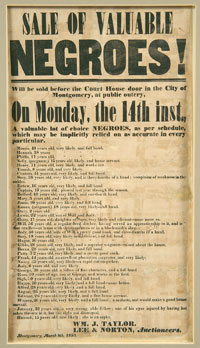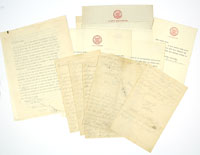
|
Sale 58
Manuscript, Collectibles and Aerospace Auction
| Lot |
Photo |
Description |
Realized |
Lot 68 |
 |
Duties of Christian Masters. By H.N. McTyeire, Southern Methodist Publishing House, Nashville, Tenn., 1859, 290pp, small octavo in brown cloth boards, lacking spine. Edges are bumped and rubbed, but a tightly-bound copy. The author, who states that he is a native South Carolinian and the son of a slaveholder, sets forth the proper manner in which slaves are to be treated by their Christian masters, opining that slaves are property but not chattel and that "Both master and servant have rights." He suggests that slaves be given rest on Sunday, as well as "Sunday" clothes and extra food, according to their work. In the chapter titled "Servants as Social Beings," he urges restraint in punishment, condemns the slave trader for breaking up families, and urges that Christianity be introduced to all servants (his euphemism for slaves). Alternatively, he warns masters that blacks are the most effective liars (being unable to blush), are jealous of their masters, and could turn church services into social gatherings. The final chapters are entirely devoted to religious instruction of slaves and their existence as religious beings. Fascinating reading and surely provocative in its time! Very rare.
Estimated Value $1,000 - 1,250.
View details and enlarged photo
| Unsold |
Lot 69 |
 |
Slave Broadside: "Sale of Valuable Negroes!" 18¼ x 10 in., Montgomery, March 8th, 1853" Listing 37 slaves, plus two unborn slaves, who "Will be sold before the Court House door in the City of Montgomery, at public outcry, On Monday, the 14th inst., A valuable lot of choice Negroes…." The auctioneers are Wm. J. Taylor. Lee & Norton. The slaves are listed by name and age; most are listed as "likely" (attractive) or "very likely" and special skills are listed, as well as any physical weaknesses. "Full hands" were especially prized since more work could be gotten from them; 16 slaves are listed as such. Nelly, 15 years old and a house servant, is pregnant, as is 18-year-old Emma. Nancy, 33, is "a rapid cotton-picker"; Frank, 44, is "an excellent plantation carpenter and very likely"; Will, 56, is "a regular-bred ditcher…and is a fine cradler--at home with the carpenters or in a blacksmith's shop"; his wife, Judy, is a "pretty good cook," as is Patty, 32. Warren, 26, is a mulatto "and would make a good house servant." January, 32, has "one of his eyes injured by having hot ashes thrown in it, but the sight not destroyed"; he is still strong and able. Susy, on the other hand, complains of weakness in the ankles and is only three-fourths of a hand.
The broadside was owned by someone who bid in the auction. Pointing fingers are drawn before the names of nine slaves, either signifying that he intended to bid on these particular slaves or that he bought them. Will is among the group marked, as is Will and Judy's 22-year-old son, Lewis, but Judy is not marked. Breakiing up families was not unusual. Two-year-old Davy, who has no parents listed, is also marked.
The broadside has been matted to 23½ x 15 in. and is ready for framing. It has not been examined out of the matte. Several repairs are noted, and some tape marks on verso (or possibly marks where old tape was removed) are visible but not intrusive. There is overall toning and a few ink stains which seem to be from the pen of the bidder. The print is quite bold and the visual impact is strong.
Estimated Value $4,000 - 6,000.
View details and enlarged photo
| Realized
$10,281 |
Lot 70 |
 |
[Spanish American War]. Autograph Letter Signed from Edwin Cole to his wife, 12pp, written in pencil (1898), giving an eyewitness account of the Battle of San Juan Hill, which was really the battle for the San Juan Heights, the most famous battle of the Spanish American War, fought on July 1, 1898. Cole went on to become the chairman of the Department of Military Science at the Massachusetts Institute of Technology, later becoming the first tech director on the Board of Directors of Harvard Cooperative Society in the 1920s. Some parts of the letter are very faint, but it comes with a very early typescript, probably done by Cole.
In part: "My darling wife: It is with devout thankfulness that I am able to write to you for my time had certainly very nearly come the other day. It was simply frightful, and we were sacrificed by trying to do against modern effective small arms what was formerly considered only a last resort. Take the famous Lookout mountain and the enemy had rifles that could be fired but twice a minute….Yet we were ordered without any attempt at flanking or maneuvering to go up and take it. We started at three in the morning and about seven came up with two of our guns in position and saw the first of it. They were firing and the enemy was answering them and the shells were bursting right over them. We halted about fifty yards away and saw several men knocked over and then we marched across their line of fire right under the bursting shells….Shortly after that we arrived in sight of a block house on top of a hill and were ordered into position. The diagram will give you an idea [he drew a diagram]. We were first ordered in the dense thicket the one on the rights of the line and several of the regiment on various parts. It was all swept by fire. Then we were successively in the open field. At one time "A" company which I joined when the fighting began was in the field where I marked up above. I was where the dot is and for some reason none of the men in my immediate vicinity were hit but the right was shot all to pieces and had to draw back and we were left alone and had to run for shelter. In trying to get through the fence I was caught by my sword belt and for thirty seconds was the only man in sight of the Spaniards and it is a miracle that I was not hit twenty times. A soldier reached up and unbuckled my belt and I got through. About ten minutes afterward we went through the fence and after them. Capt. [Alexander Macomb] Wetherill went through our opening and I followed him. Some of the men did not come and I turned back and yelled at them and swore at them and stayed at that fence holding apart the wires for several minutes. When I turned to the fence I saw Wetherill and 30 seconds afterward I missed him and we never got a chance to look for him until 24 hrs. afterward Atkinson found his body. He was shot through he forehead and did not go a yard after he got through the fence. I ran on up to the top of the hill. When I got there the enemy was in full retreat. [1st Lt. Jules Garesche] Ord was killed leading the charge right at the top [he led the Buffalo Soldiers of the 10th U.S. Cavalry]. Our regiment outfired terribly, losing 137 killed, wounded, and missing out of 450. "A" company lost 4 killed and 9 wounded, 2 not accounted for, probably dead…. I have been through one of the most, if not the most terrible battle in history and I never want to hear another shot…."
Colonel Theodore Roosevelt led his Rough Riders on the charge up the hill and rode the fame to the governorship of New York and the vice presidency of the U.S., becoming president when McKinnley was assassinated.
Estimated Value $3,500 - 4,500.
View details and enlarged photo
| Unsold |
|
|